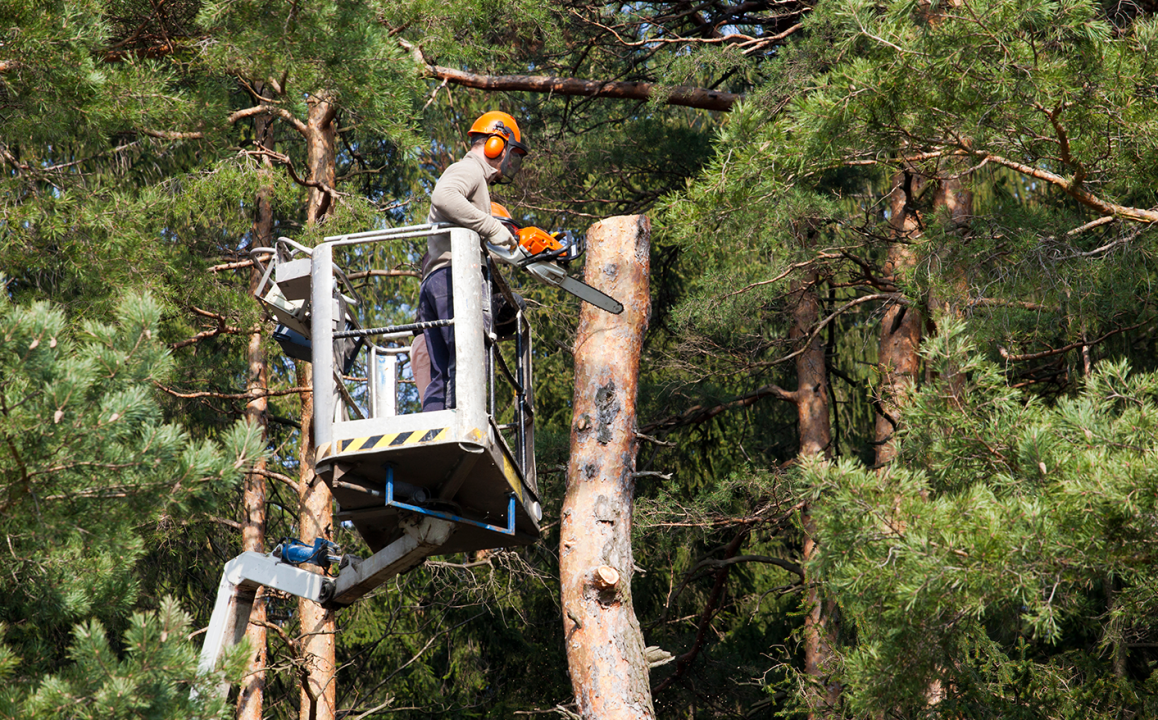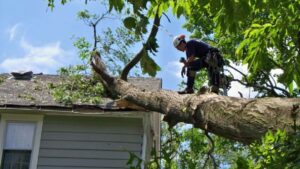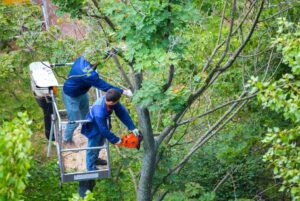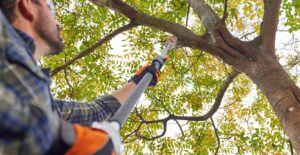A Complete Guide Commercial Tree Removal
What is Commercial Tree Removal?
Commercial tree removal involves the professional elimination of trees from commercial properties like office parks, shopping centers, construction sites, industrial facilities, and municipal properties. This service is necessary when trees pose a safety risk, obstruct development, or require removal for landscaping or construction purposes. Unlike residential tree removal, commercial tree removal typically involves larger trees, complex access, and advanced equipment due to the larger scale of projects.
Commercial properties may also face unique challenges like having to comply with local regulations, protect surrounding infrastructure, or manage high foot traffic, all of which demand experienced arborists and heavy-duty machinery.
Average Cost of Commercial Tree Removal in the USA
The cost of commercial tree removal can vary based on several factors, such as tree size, location, equipment needs, and regional differences. The average cost of commercial tree removal in the USA typically ranges from $2,500 to $7,500 per tree, with more complex projects potentially exceeding this range.
Here’s a table outlining the average cost in 25 top cities across the U.S.
Average Cost of Commercial Tree Removal by City
| City, State | Average Price (USD) |
|---|---|
| New York, NY | $6,000 – $12,000 |
| Los Angeles, CA | $5,000 – $10,000 |
| Chicago, IL | $4,500 – $9,000 |
| Houston, TX | $3,500 – $8,000 |
| Phoenix, AZ | $3,000 – $7,500 |
| Philadelphia, PA | $4,000 – $9,500 |
| San Antonio, TX | $3,200 – $7,800 |
| San Diego, CA | $5,000 – $10,000 |
| Dallas, TX | $3,500 – $8,000 |
| San Jose, CA | $5,000 – $9,500 |
| Austin, TX | $3,500 – $8,500 |
| Jacksonville, FL | $4,000 – $8,000 |
| San Francisco, CA | $5,500 – $10,500 |
| Columbus, OH | $3,800 – $7,500 |
| Indianapolis, IN | $3,500 – $7,500 |
| Fort Worth, TX | $3,200 – $7,500 |
| Charlotte, NC | $4,200 – $8,500 |
| Seattle, WA | $5,000 – $10,500 |
| Denver, CO | $4,500 – $9,500 |
| Washington, D.C. | $5,500 – $11,000 |
| Boston, MA | $5,000 – $10,000 |
| El Paso, TX | $3,200 – $7,000 |
| Detroit, MI | $3,800 – $8,500 |
| Nashville, TN | $4,000 – $8,500 |
| Portland, OR | $4,800 – $9,500 |
The wide range in prices reflects differences in local labor costs, equipment availability, tree height, tree species, and ease of access.
The Process of Commercial Tree Removal
The process of commercial tree removal follows a step-by-step approach to ensure efficiency, safety, and compliance with local regulations. Below is a detailed look at the steps involved in commercial tree removal:
1. Assessment
- A certified arborist inspects the tree(s) and surrounding property to assess the risk, size, health, and potential challenges, like proximity to power lines or structures.
- Arborists will also check for any local permits or ordinances that may affect the removal process.
2. Obtaining Permits
- Some cities or states require permits for commercial tree removal, especially for trees that are considered historic or protected.
- The company manages the permit application process to ensure compliance with all local laws.
3. Planning and Equipment Selection
- After the assessment, the tree removal team decides what equipment will be necessary, such as chainsaws, cranes, aerial lifts, or wood chippers.
- A detailed plan is created to minimize impact on surrounding infrastructure and reduce safety risks.
4. Site Preparation
- The area around the tree is cleared of obstacles and marked for safety.
- Safety measures, such as setting up barriers or alert signs, are implemented to ensure protection for workers and people in the vicinity.
5. Tree Removal
- Cutting: The tree is cut down in sections using cranes or aerial lifts, starting with the smaller branches and working down to the main trunk.
- Crane Usage: For particularly large trees or hard-to-reach areas, a crane may be employed to safely remove large sections without damaging nearby buildings or infrastructure.
- Felling: In open areas, the tree may be felled whole, but this is rare in commercial settings due to proximity to other structures.
6. Wood and Debris Removal
- After the tree is cut down, the team chips smaller branches for mulch, while larger sections of wood may be cut into logs for removal.
- All debris is removed from the site, leaving it clean and ready for further use.
7. Stump Grinding
- In most cases, the stump is ground down to ensure it doesn’t pose a trip hazard or ruin the aesthetic of the landscape.
- In some cases, full stump removal is performed, which may require additional machinery like excavators.
8. Site Restoration
- After the tree removal, the site is often restored with topsoil or sod to prepare it for future landscaping or development.
How is Commercial Tree Removal Different from Residential?
Commercial tree removal differs significantly from residential tree removal in several ways:
- Scope: Commercial properties are often larger and may involve the removal of multiple trees, whereas residential removal typically focuses on a few trees at most.
- Equipment: Commercial jobs require more heavy-duty equipment, such as cranes, large tree spades, and industrial wood chippers, while residential jobs may only need basic equipment like chainsaws and ladders.
- Permits and Regulations: Commercial properties may face stricter regulatory requirements, such as the need for permits, environmental assessments, and compliance with city ordinances.
- Safety and Liability: Commercial tree removal often involves more complex safety considerations due to the proximity of high-traffic areas, power lines, or large buildings.
- Cost: The average cost of commercial tree removal tends to be higher due to the size and complexity of the projects.
Top 25 Companies Offering Commercial Tree Removal Services
Below is a list of 25 top companies in the USA that provide commercial tree removal services.
| Company Name | City & State | Phone Number | Website |
|---|---|---|---|
| Davey Tree Expert Company | Kent, OH | (800) 445-8733 | davey.com |
| Bartlett Tree Experts | Stamford, CT | (877) 227-8538 | bartlett.com |
| SavATree | Bedford Hills, NY | (914) 241-4999 | savatree.com |
| BrightView Tree Care | Blue Bell, PA | (484) 567-6887 | brightview.com |
| The F.A. Bartlett Company | Stanford, CT | (203) 323-1131 | bartlett.com |
| Monster Tree Service | Fort Washington, PA | (610) 616-0004 | monstertreeservice.com |
| ACRT Services | Stow, OH | (800) 622-2562 | acrt.com |
| Asplundh Tree Expert | Willow Grove, PA | (800) 248-8733 | asplundh.com |
| Tree Top Inc. | Woburn, MA | (781) 935-8733 | treetopinc.com |
| TruGreen | Memphis, TN | (844) 567-9909 | trugreen.com |
| Nelson Tree Service | Dayton, OH | (937) 293-4100 | nelsontree.com |
| Terra Tree Removal | Tampa, FL | (813) 877-8733 | terratreeremoval.com |
| Top Tier Tree Service | Denver, CO | (720) 630-8733 | toptiertree.com |
| North American Tree | Los Angeles, CA | (310) 933-8733 | natreeservice.com |
| AAA Tree Experts | Atlanta, GA | (404) 252-8733 | aaatreeexperts.com |
| Capitol Tree Care | Austin, TX | (512) 913-8733 | capitoltreecare.com |
| Terra Verde Tree Service | Phoenix, AZ | (602) 555-8733 | terraverde.com |
| Northwest Tree Specialists | Portland, OR | (503) 555-8733 | northwesttree.com |
| Mid-Atlantic Tree Experts | Washington, DC | (202) 555-8733 | midat |
Here’s a list of equipment commonly used in commercial tree removal:
- Chainsaws: Essential for cutting through tree trunks and large branches quickly and efficiently.
- Aerial Lifts: These platforms provide access to higher branches, making it easier to trim or remove large trees.
- Cranes: Used for lifting heavy tree sections safely, especially in tight spaces or near structures.
- Wood Chippers: Machines that shred branches and wood into mulch, reducing the volume of debris.
- Stump Grinders: Equipment designed to grind down tree stumps below ground level, eliminating trip hazards.
- Excavators: Used for digging out tree stumps or preparing the site for new landscaping after a tree is removed.
- Safety Gear: Including helmets, gloves, goggles, and harnesses to ensure worker safety during tree removal.
- Rigging Equipment: Ropes, pulleys, and harnesses that help control the fall of large branches or sections of the tree.
- Chippers and Log Splitters: For processing removed trees into smaller, manageable pieces.
- Ground Saw: A saw mounted on the ground that cuts trees near the base, used in certain specialized situations.
- Brush Cutters: Used for clearing underbrush and smaller trees before removing larger trees.
- Transport Vehicles: Trucks or trailers for transporting removed trees and equipment to and from the job site.
- Tree Spades: Used for moving smaller trees intact from one location to another.
- Hydraulic Lifts: Similar to aerial lifts but can also be used for lifting heavy equipment or tree sections.
- Soil Augers: Sometimes used to prepare the ground for replanting after tree removal, especially for larger projects.
Using the appropriate equipment is crucial for ensuring the safety and efficiency of commercial tree removal operations.
FAQs About Commercial Tree Removal
- What is commercial tree removal?
- Commercial tree removal involves the professional cutting and removal of trees from commercial properties, such as office parks, shopping centers, or construction sites. It requires specialized equipment and expertise to safely and efficiently remove trees without causing damage to surrounding structures or landscapes.
- How is commercial tree removal different from residential tree removal?
- Commercial tree removal is generally larger in scale, involves bigger or more hazardous trees, and often requires specialized equipment like cranes. It also tends to follow stricter regulatory guidelines compared to residential tree removal, due to the proximity of commercial buildings and high-traffic areas.
- What is the average cost of commercial tree removal in the U.S.?
- The average cost of commercial tree removal in the U.S. ranges from $2,500 to $7,500 per tree, depending on factors such as the tree’s size, location, and condition. More complex projects, such as those involving large trees or hazardous conditions, can cost even more.
- What factors affect the cost of commercial tree removal?
- The main factors affecting the cost of commercial tree removal include the size of the tree, its location, the equipment required, potential hazards, and local permit requirements. Accessibility and proximity to buildings or power lines can also increase the cost.
- What permits are required for commercial tree removal?
- Depending on the location, commercial tree removal may require local or state permits, especially if the trees are protected species or located in a conservation area. An arborist will usually handle the permit application process on behalf of the property owner.
- What equipment is used for commercial tree removal?
- Commercial tree removal often involves heavy-duty equipment, including cranes, aerial lifts, chainsaws, and wood chippers. For large or hard-to-reach trees, cranes may be used to safely remove the tree in sections without damaging nearby structures.
- Can commercial tree removal be done year-round?
- Yes, commercial tree removal can be performed year-round, but certain seasons may be more optimal. Winter is often preferred because trees are dormant, which can make removal easier, while the dry summer season may reduce complications from wet soil or weather-related delays.
- How long does it take to remove a large tree on commercial property?
- The time required to remove a tree varies depending on the tree’s size, location, and complexity of the job. A standard tree removal can take anywhere from a few hours to a full day, while more complex removals may take multiple days.
- What happens to the tree after it is removed?
- After removal, the tree is typically cut into sections, with branches chipped into mulch and larger logs hauled away. Some companies offer to leave the wood for the property owner, while others will fully dispose of all debris, depending on the client’s preference.
- Do commercial tree removal companies offer stump grinding?
- Yes, most commercial tree removal services include stump grinding as an optional add-on. Stump grinding helps eliminate trip hazards and prevents regrowth. Some clients opt for full stump removal, which may require excavation but ensures the tree is entirely removed.
- Is it necessary to hire an arborist for commercial tree removal?
- Yes, hiring a certified arborist is important for commercial tree removal. Arborists have the expertise to assess tree health, recommend proper removal methods, and ensure that removal complies with local regulations. They also handle safety measures and manage risks associated with large or hazardous trees.
- Can tree removal damage my commercial property?
- When performed by a professional, tree removal should not damage the property. Expert tree removal companies use precise cutting techniques, cranes, and rigging to ensure that nearby structures, landscaping, and utilities are protected throughout the removal process.
- Are there any risks involved in commercial tree removal?
- Yes, commercial tree removal can involve risks, including falling branches, equipment failure, or damage to nearby structures. However, professional tree removal companies mitigate these risks by using proper safety measures, skilled workers, and industry-standard equipment.
- How can I prepare for a commercial tree removal project?
- To prepare for a tree removal project, clear the area around the tree of vehicles, equipment, or any valuable items. Inform employees or tenants about the upcoming work, and ensure that permits and local regulations have been addressed by the arborist or contractor.
- What services are included in commercial tree removal?
- Commercial tree removal typically includes tree cutting, removal of the tree in sections, wood chipping, debris removal, and stump grinding. Some companies offer additional services like tree trimming, site restoration, and land clearing as part of a broader property management package.





